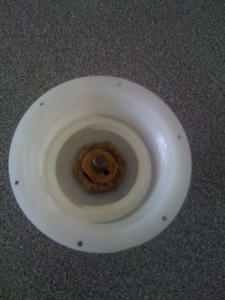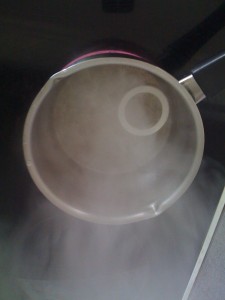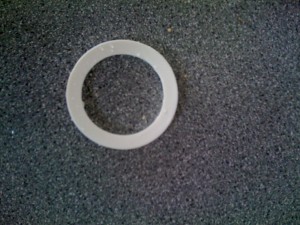Consumption of my latest home brew began in earnest this week. I wasn’t really sure what to expect of this one… it was a bit of an emergency standby. I *had* planned to make a barrel of Colne Valley bitter, as there was an online shop selling off kits at an unbelievably cheap price. As it turns out, the unbelievability (is that a real word?) of the price was entirely justified, as — after 6 weeks of palming me off with various excuses as to why the delivery was being delayed — the company went belly up, disappearing off the net, and leaving a lot of angry customers behind. Fortunately, I got my money refunded a few hours before their site disappeared. Unfortunately — by this time — my brew schedule was way out of whack and I was looking at the imminent risk of empty barrels in my garage…
So, I went into Newcastle to see what I could find. I’d read that Wilkinsons do a few bits and bobs of home brew these days… and, while the range might be a bit limited, I’m a great believer the adage of “any port in a storm”…
I came home with a tin of Geordie-brand “Yorkshire Bitter” wort, and a bag of beer enhancer. I’ve made a different Geordie Bitter kit in the past, which was cheap, cheerful, and perfectly drinkable – I’d used beer enhancer that time too, so thought I’d stick to a similar plan. (For the uninitiated: “Beer enhancer” generally comprises a bag full of sugary fermentables that you add to a beer kit in place of ordinary sugar. It’s made of a combination of unrefined “brewers” sugar, and spray-dried malt …and gives you a much better taste and body than if you use bog-standard Tate + Lyle!).
The brew went really smoothly, with a really fast fermentation… probably the fastest one I’ve ever had (the unseasonably warm week of weather we had at the end of March really helped!)…

…and was kegged and bottled at the start of April. I tried one of the bottles after the minimum recommended maturation period (a fortnight) and… urm… it was a little on the rough side. Waited another fortnight, and things were still not much improved. No matter; I was due to go on one of Mrs Shep’s mad adventures around the country for a couple of weeks, so hopefully things would be shaping when I got back.
Lo and behold… a couple more weeks have turned it into a really nice drink. It’s not, really, what I’d consider to be a typical “Yorkshire” bitter – it doesn’t quite have the signature sweetness to it, and seems pretty aggressively hopped… but it’s not a bad pint at all; very easy drinking, and I suppose — if it lasts that long — the taste might change some more given a couple more weeks (that’s one of the more interesting aspects of making a “living” drink like a real ale; the taste is continually changing…)
Anyway: on to the ‘crisis’ mentioned in the title. After I’d poured a couple of drinks, I started to notice that the barrel pressure seemed to be dropping way faster than I expected… and the next day, the beer seemed to be significantly more lifeless than the day before. Pretty much the worst thing that can happen with kegged beer is you get into a situation where the gas pressure drops inside your barrel, and oxygen gets sucked in through the tap (AKA the glug of doom!!!). This oxidises your beer. Oxidised beer tastes… not good.
Fortunately this particular keg has a CO2 injector valve on it, and I had a couple of carbon dioxide bulbs to hand, so I gave the brew a quick blast of gas. (This is a pretty common way to deal with low pressure situations… though you usually don’t need to resort to this trick until your keg is at least half empty). Almost immediately the problem became apparent – I could hear the gas hissing straight back out of the screw thread at the top of the keg, and no amount of fiddling with the cap would make it stop. The air-tight seal on the lid had obviously failed… Badly!
Generally, once your keg is all sealed up, you don’t want to open it again until the beer has been drunk, or you run the risk of nasty things getting into the beer, and/or the beer going flat. However, it now looked like there was no other course of action. I popped the lid off, and this is what I found…

OK, it’s maybe not obvious in that pic, let me prise the seal out so you can see it better:

This thing is supposed to be perfectly flat and smooth. Not twisted, mangled, and Möbius-loopy like this. I’ve got no idea how it got into this state, but can only assume it came loose as I was screwing the top onto the keg, and got a bit caught up on the thread. I’m surprised the barrel held any pressure at all!
It seemed to be pretty much ‘set’ that way, and looked a bit beyond repair… and I had no idea how I was going to get the barrel gas-tight again at short notice without a new seal (this was pretty late at night, so a mad dash to a friendly local home brew shop was not on the cards). Was my beloved new brew doomed to go flat???
“Stand Back… I’m about to do… SCIENCE!”
Do you remember being taught about plastic memory effect in school science lessons? The way that certain polymers return to their original shape when heated?? Well, I had no idea if *this* particular lump of plastic would be the right stuff to demonstrate that particular effect, but — on balance — it seemed to be worth a shot. I put a little bit of water in a saucepan, set it boiling, and submerged the damaged seal for a few seconds…

The result…

Amazing! It looks good as new!! … I popped a bit of extra sugar into the barrel (hoping to either (a) kickstart the dormant yeast culture, or (b) work as some kind of nucleation point and make any dissolved carbon dioxide fizz up a bit), and then (gently!) screwed the repaired lid back on. Finally – deciding to go for the full belt-and-braces all-or-nothing approach – blasted my last remaining CO2 cartridge into the barrel. It seemed to hold. ‘Phew.
One day later… the beer is now pouring like a dream, and has a nice frothy head on it. Rescue mission successful – Hooray for science! Hooray for beer! 🙂

 Follow
Follow